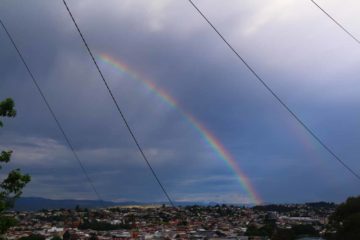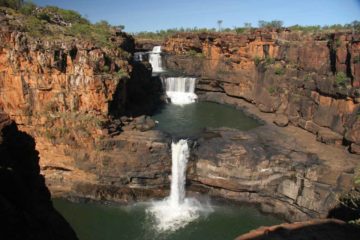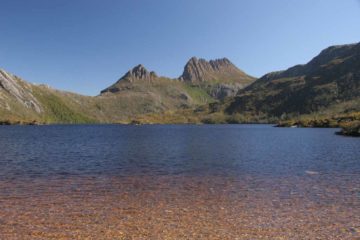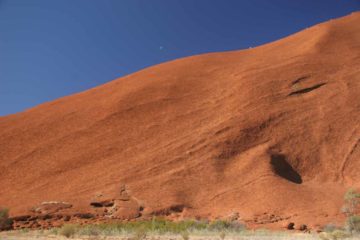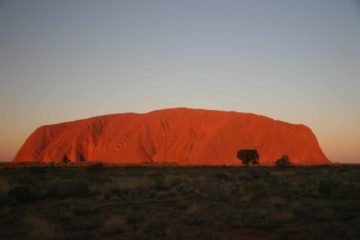About Montezuma Falls
Montezuma Falls had to have been one of the more impressive and memorable waterfalls that Julie and I had visited in Tasmania. It was definitely up there as one of the best waterfalls we had seen in Australia, and by its inclusion in our Top 10 Australia Waterfalls List, that should tell you how highly we thought of this attraction. Indeed, the falls tumbled at a cumulative height of 104m making it one of the highest waterfalls in the island state. In addition to the waterfall itself, we even managed to get quite the thrill from standing on a harrowing suspension bridge spanning the george well above Montezuma Creek (or Avon Creek) to view the falls. Julie and I had also found this place to be tranquil and naturesque despite its history.
Like with most things that were worthwhile, we had to earn our visit with a bit of a long walk. The walking track followed the old North East Dundas Tramway route that used to run between Zeehan and the old site of Williamsford in the 1890s. As a result of its past as a place to extract resources, the trail also featured a mine shaft, railroad track remnants, recovering old growth rainforest, and some side waterfalls. Although the excursion was said to take 3 hours round trip, Julie and I took around 3 hours and 15 minutes though some of that time was for picture-taking. According to my GPS logs, the track was around 9.6km to 10km long. That said, despite the track’s length, the entire walk was flat (as well as mostly shaded) as most of the trailblazing work was already done with the construction of the tramway.
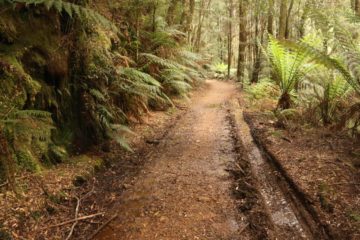
After about another 150m, there was a sign talking about how there were about 60 bends for every two kilometres in distance along a line (or about 6km of tramway). To the left of the track near this sign was a small side waterfall that was barely flowing behind the thick bush. The track would continue to be flanked by ferns, tall trees, and some walls that might have been blasted to make way for the tramway. I also noticed some tyre tracks barely fitting within the narrow walking track suggesting that it wasn’t that rare for offroad enthusiasts to be driving here.
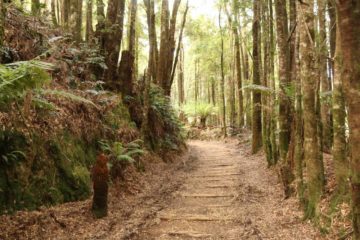
Along this walkers-only section, the wooden planks that once spanned the rails of the tramway were definitely more apparent and abundant. After nearly 600m from the sign, I spotted another side waterfall on the left, where it was possible to get up to with a little scrambling amongst the bush. Also nearby this spot, it appeared that the track started to follow Montezuma Creek instead of the Ring River. Roughly another 300m further, the track then passed right by a former mine shaft entrance, where the tunnel went deep enough to block out a fair bit of light before reaching a barricade.
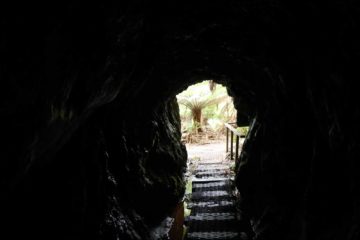
On the other side of the bridge, it appeared that the rapid growth of the rainforest (aided by 3m of annual rainfall) obstructed the view of the falls as of our latest visit in late November 2017. On our first visit back in late November 2006, I was able to photograph Julie watching Montezuma Falls while she was standing in the middle of the bridge!
After having our fill of the suspension bridge, we went back to the fork and took the other path, where the track ultimately terminated at the foot of Montezuma Falls’ giant drop. There was a lookout deck (for a neck-cranking view) as well as an opportunity to do a little scrambling on fallen rocks to get close enough to the falls to feel its spray. Of course, those fallen rocks were also reminders of the hazards of getting too close to such a waterfall. In any case, it was worth noting that since this was a northwest facing waterfall, the morning sun had the potential of being in a bad spot once it breached the towering cliffs here. So if it was sunny, then early to mid afternoon would yield perhaps the most agreeable backlighting. Otherwise, it’d have to be cloudy or shadowy enough where everything in the shade would have uniform lighting, including the waterfall.
Finally regarding the name of Montezuma Falls, I often wondered how the name of the last Aztec emperor made its way to the West Coast of Tasmania. Well, a sign along the track informed us that the name came from the Montezuma Mining Company, which used to mine for silver here in the 1890s (I think two of the signs there had a typo suggesting they were here in the 1980s). It was said that during the mining heydey, much of the forest around the tramway had been cleared, but we hardly knew this was the case during our hike as the forest seemed to have recovered around the track nicely. Prior to the Montezuma Mining Company owning leases in the area, the falls used to be referred to as Osbourne Falls.
Related Top 10 Lists
Trip Planning Resources
Nearby Accommodations
This content is for members only. See Membership Options.Featured Images and Nearby Attractions
This content is for members only. See Membership Options.Visitor Comments:
Got something you'd like to share or say to keep the conversation going? Feel free to leave a comment below...No users have replied to the content on this page
Visitor Reviews of this Waterfall:
If you have a waterfall story or write-up that you'd like to share, feel free to click the button below and fill out the form...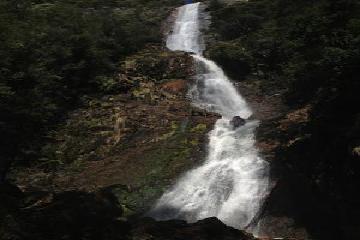 Top 10 Tasmanian waterfalls May 22, 2015 10:42 am - I have visited quite a few waterfalls in Tasmania (roughly 45-50) and I thought that it was about time that I compiled a top 10 list based on the falls that I have seen. 10. WARATAH FALLS Waratah Falls is an impressive 40-odd metre high waterfall that I enjoyed for a couple of reasons. Firstly,… ...Read More
Top 10 Tasmanian waterfalls May 22, 2015 10:42 am - I have visited quite a few waterfalls in Tasmania (roughly 45-50) and I thought that it was about time that I compiled a top 10 list based on the falls that I have seen. 10. WARATAH FALLS Waratah Falls is an impressive 40-odd metre high waterfall that I enjoyed for a couple of reasons. Firstly,… ...Read More
